Governance, Ethics, and Sustainability Risks
VerifiedAdded on 2023/04/23
|12
|2828
|370
AI Summary
Contribute Materials
Your contribution can guide someone’s learning journey. Share your
documents today.
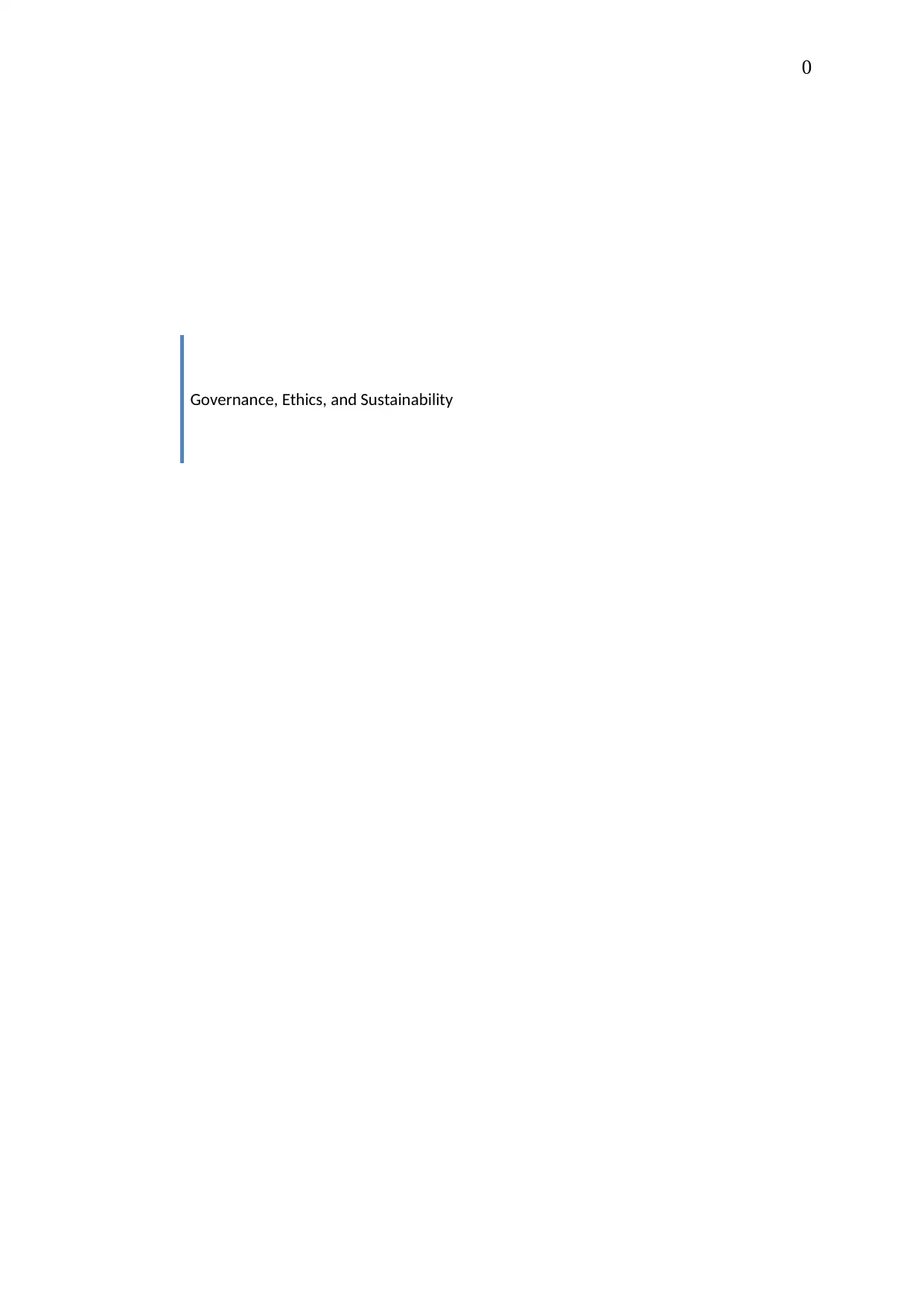
0
Governance, Ethics, and Sustainability
Governance, Ethics, and Sustainability
Secure Best Marks with AI Grader
Need help grading? Try our AI Grader for instant feedback on your assignments.
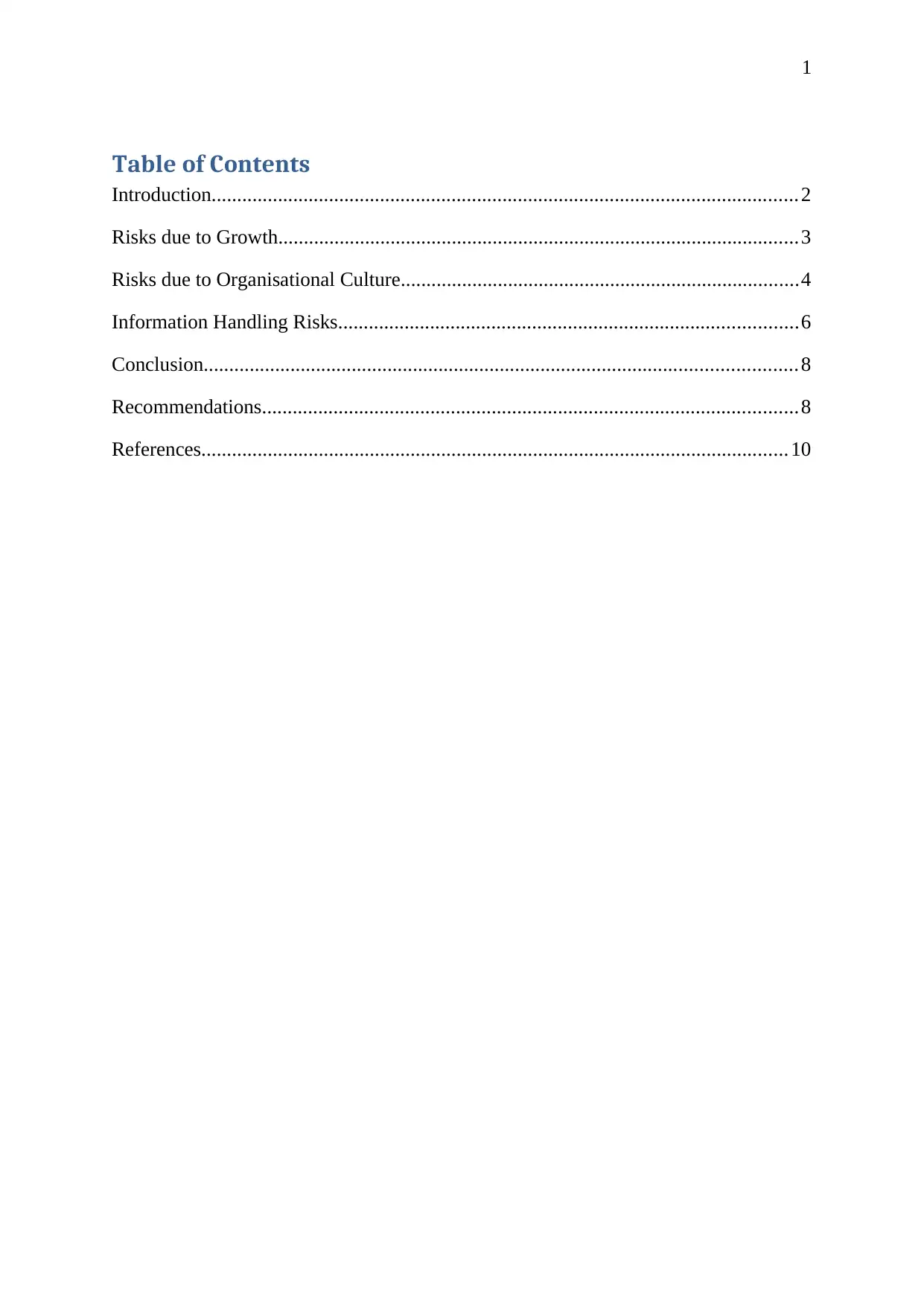
1
Table of Contents
Introduction...................................................................................................................2
Risks due to Growth......................................................................................................3
Risks due to Organisational Culture..............................................................................4
Information Handling Risks..........................................................................................6
Conclusion....................................................................................................................8
Recommendations.........................................................................................................8
References................................................................................................................... 10
Table of Contents
Introduction...................................................................................................................2
Risks due to Growth......................................................................................................3
Risks due to Organisational Culture..............................................................................4
Information Handling Risks..........................................................................................6
Conclusion....................................................................................................................8
Recommendations.........................................................................................................8
References................................................................................................................... 10
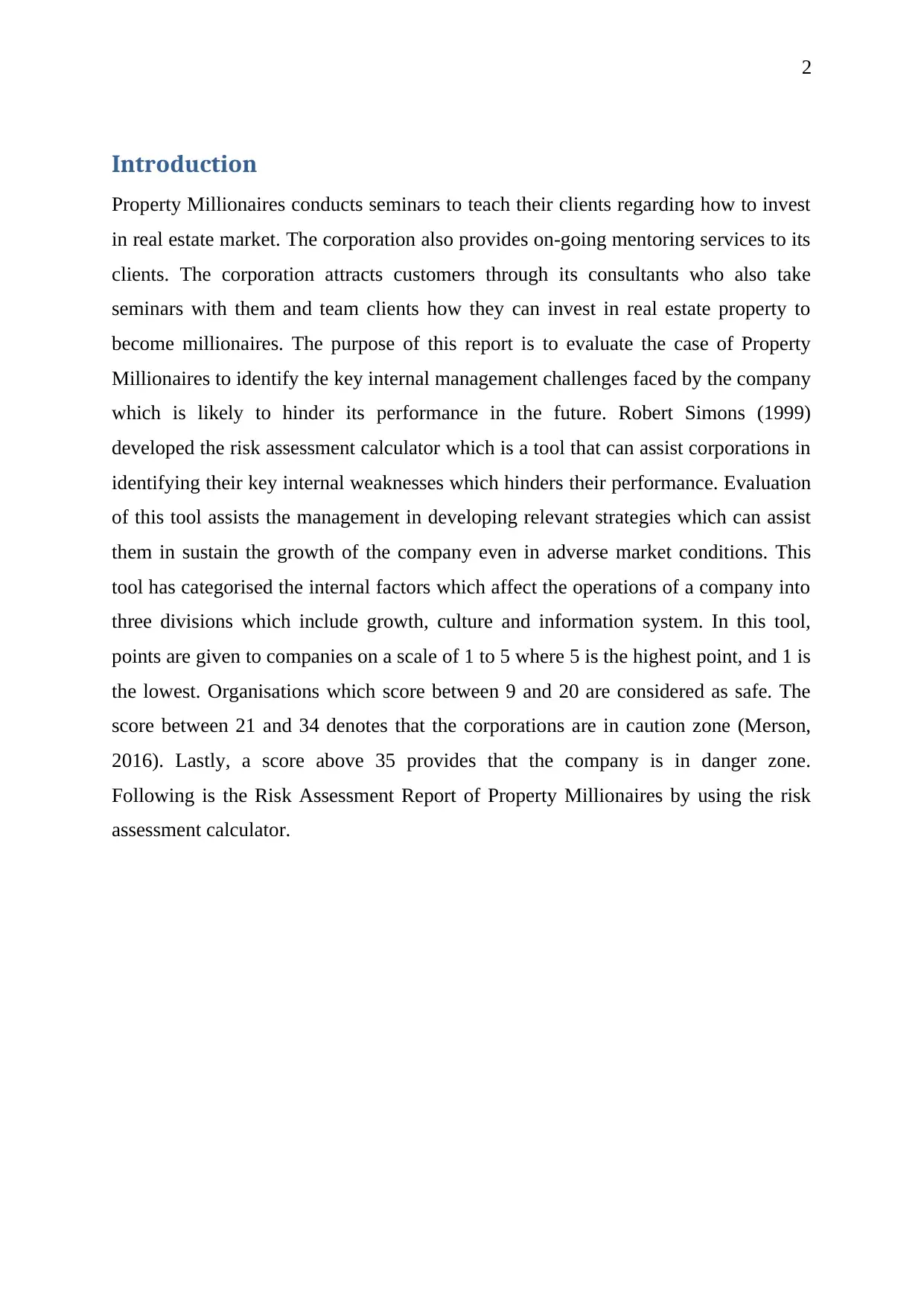
2
Introduction
Property Millionaires conducts seminars to teach their clients regarding how to invest
in real estate market. The corporation also provides on-going mentoring services to its
clients. The corporation attracts customers through its consultants who also take
seminars with them and team clients how they can invest in real estate property to
become millionaires. The purpose of this report is to evaluate the case of Property
Millionaires to identify the key internal management challenges faced by the company
which is likely to hinder its performance in the future. Robert Simons (1999)
developed the risk assessment calculator which is a tool that can assist corporations in
identifying their key internal weaknesses which hinders their performance. Evaluation
of this tool assists the management in developing relevant strategies which can assist
them in sustain the growth of the company even in adverse market conditions. This
tool has categorised the internal factors which affect the operations of a company into
three divisions which include growth, culture and information system. In this tool,
points are given to companies on a scale of 1 to 5 where 5 is the highest point, and 1 is
the lowest. Organisations which score between 9 and 20 are considered as safe. The
score between 21 and 34 denotes that the corporations are in caution zone (Merson,
2016). Lastly, a score above 35 provides that the company is in danger zone.
Following is the Risk Assessment Report of Property Millionaires by using the risk
assessment calculator.
Introduction
Property Millionaires conducts seminars to teach their clients regarding how to invest
in real estate market. The corporation also provides on-going mentoring services to its
clients. The corporation attracts customers through its consultants who also take
seminars with them and team clients how they can invest in real estate property to
become millionaires. The purpose of this report is to evaluate the case of Property
Millionaires to identify the key internal management challenges faced by the company
which is likely to hinder its performance in the future. Robert Simons (1999)
developed the risk assessment calculator which is a tool that can assist corporations in
identifying their key internal weaknesses which hinders their performance. Evaluation
of this tool assists the management in developing relevant strategies which can assist
them in sustain the growth of the company even in adverse market conditions. This
tool has categorised the internal factors which affect the operations of a company into
three divisions which include growth, culture and information system. In this tool,
points are given to companies on a scale of 1 to 5 where 5 is the highest point, and 1 is
the lowest. Organisations which score between 9 and 20 are considered as safe. The
score between 21 and 34 denotes that the corporations are in caution zone (Merson,
2016). Lastly, a score above 35 provides that the company is in danger zone.
Following is the Risk Assessment Report of Property Millionaires by using the risk
assessment calculator.
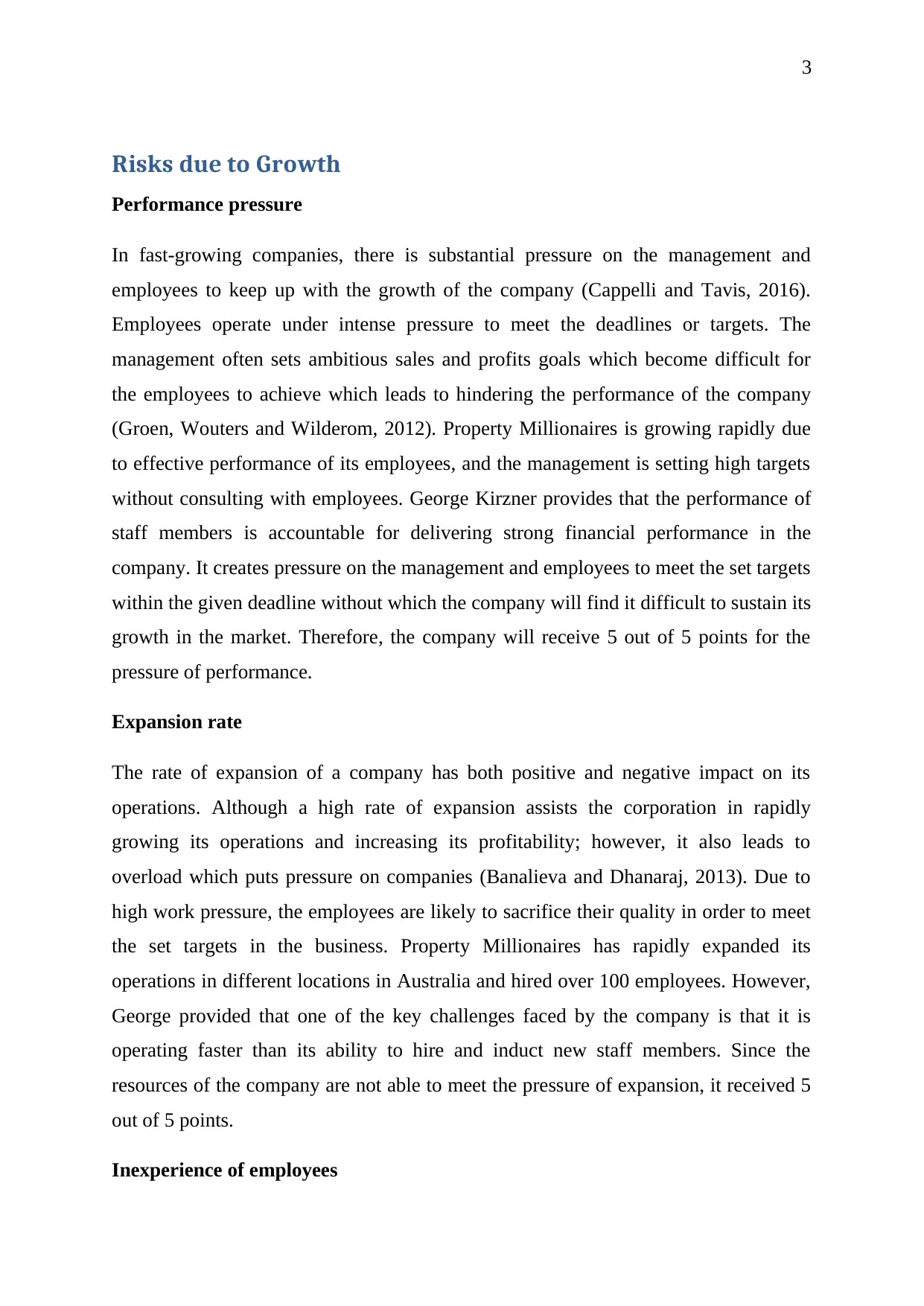
3
Risks due to Growth
Performance pressure
In fast-growing companies, there is substantial pressure on the management and
employees to keep up with the growth of the company (Cappelli and Tavis, 2016).
Employees operate under intense pressure to meet the deadlines or targets. The
management often sets ambitious sales and profits goals which become difficult for
the employees to achieve which leads to hindering the performance of the company
(Groen, Wouters and Wilderom, 2012). Property Millionaires is growing rapidly due
to effective performance of its employees, and the management is setting high targets
without consulting with employees. George Kirzner provides that the performance of
staff members is accountable for delivering strong financial performance in the
company. It creates pressure on the management and employees to meet the set targets
within the given deadline without which the company will find it difficult to sustain its
growth in the market. Therefore, the company will receive 5 out of 5 points for the
pressure of performance.
Expansion rate
The rate of expansion of a company has both positive and negative impact on its
operations. Although a high rate of expansion assists the corporation in rapidly
growing its operations and increasing its profitability; however, it also leads to
overload which puts pressure on companies (Banalieva and Dhanaraj, 2013). Due to
high work pressure, the employees are likely to sacrifice their quality in order to meet
the set targets in the business. Property Millionaires has rapidly expanded its
operations in different locations in Australia and hired over 100 employees. However,
George provided that one of the key challenges faced by the company is that it is
operating faster than its ability to hire and induct new staff members. Since the
resources of the company are not able to meet the pressure of expansion, it received 5
out of 5 points.
Inexperience of employees
Risks due to Growth
Performance pressure
In fast-growing companies, there is substantial pressure on the management and
employees to keep up with the growth of the company (Cappelli and Tavis, 2016).
Employees operate under intense pressure to meet the deadlines or targets. The
management often sets ambitious sales and profits goals which become difficult for
the employees to achieve which leads to hindering the performance of the company
(Groen, Wouters and Wilderom, 2012). Property Millionaires is growing rapidly due
to effective performance of its employees, and the management is setting high targets
without consulting with employees. George Kirzner provides that the performance of
staff members is accountable for delivering strong financial performance in the
company. It creates pressure on the management and employees to meet the set targets
within the given deadline without which the company will find it difficult to sustain its
growth in the market. Therefore, the company will receive 5 out of 5 points for the
pressure of performance.
Expansion rate
The rate of expansion of a company has both positive and negative impact on its
operations. Although a high rate of expansion assists the corporation in rapidly
growing its operations and increasing its profitability; however, it also leads to
overload which puts pressure on companies (Banalieva and Dhanaraj, 2013). Due to
high work pressure, the employees are likely to sacrifice their quality in order to meet
the set targets in the business. Property Millionaires has rapidly expanded its
operations in different locations in Australia and hired over 100 employees. However,
George provided that one of the key challenges faced by the company is that it is
operating faster than its ability to hire and induct new staff members. Since the
resources of the company are not able to meet the pressure of expansion, it received 5
out of 5 points.
Inexperience of employees
Secure Best Marks with AI Grader
Need help grading? Try our AI Grader for instant feedback on your assignments.
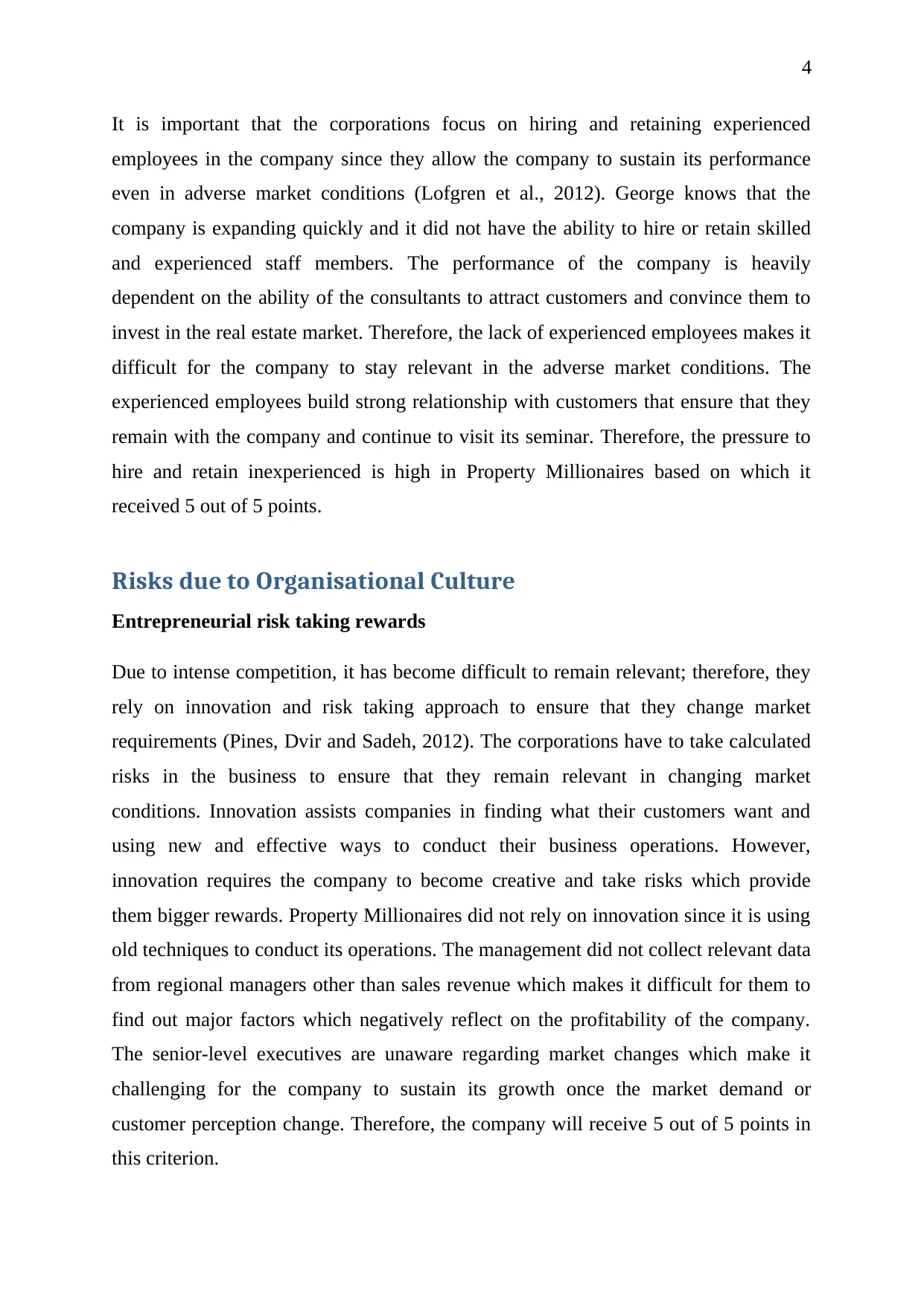
4
It is important that the corporations focus on hiring and retaining experienced
employees in the company since they allow the company to sustain its performance
even in adverse market conditions (Lofgren et al., 2012). George knows that the
company is expanding quickly and it did not have the ability to hire or retain skilled
and experienced staff members. The performance of the company is heavily
dependent on the ability of the consultants to attract customers and convince them to
invest in the real estate market. Therefore, the lack of experienced employees makes it
difficult for the company to stay relevant in the adverse market conditions. The
experienced employees build strong relationship with customers that ensure that they
remain with the company and continue to visit its seminar. Therefore, the pressure to
hire and retain inexperienced is high in Property Millionaires based on which it
received 5 out of 5 points.
Risks due to Organisational Culture
Entrepreneurial risk taking rewards
Due to intense competition, it has become difficult to remain relevant; therefore, they
rely on innovation and risk taking approach to ensure that they change market
requirements (Pines, Dvir and Sadeh, 2012). The corporations have to take calculated
risks in the business to ensure that they remain relevant in changing market
conditions. Innovation assists companies in finding what their customers want and
using new and effective ways to conduct their business operations. However,
innovation requires the company to become creative and take risks which provide
them bigger rewards. Property Millionaires did not rely on innovation since it is using
old techniques to conduct its operations. The management did not collect relevant data
from regional managers other than sales revenue which makes it difficult for them to
find out major factors which negatively reflect on the profitability of the company.
The senior-level executives are unaware regarding market changes which make it
challenging for the company to sustain its growth once the market demand or
customer perception change. Therefore, the company will receive 5 out of 5 points in
this criterion.
It is important that the corporations focus on hiring and retaining experienced
employees in the company since they allow the company to sustain its performance
even in adverse market conditions (Lofgren et al., 2012). George knows that the
company is expanding quickly and it did not have the ability to hire or retain skilled
and experienced staff members. The performance of the company is heavily
dependent on the ability of the consultants to attract customers and convince them to
invest in the real estate market. Therefore, the lack of experienced employees makes it
difficult for the company to stay relevant in the adverse market conditions. The
experienced employees build strong relationship with customers that ensure that they
remain with the company and continue to visit its seminar. Therefore, the pressure to
hire and retain inexperienced is high in Property Millionaires based on which it
received 5 out of 5 points.
Risks due to Organisational Culture
Entrepreneurial risk taking rewards
Due to intense competition, it has become difficult to remain relevant; therefore, they
rely on innovation and risk taking approach to ensure that they change market
requirements (Pines, Dvir and Sadeh, 2012). The corporations have to take calculated
risks in the business to ensure that they remain relevant in changing market
conditions. Innovation assists companies in finding what their customers want and
using new and effective ways to conduct their business operations. However,
innovation requires the company to become creative and take risks which provide
them bigger rewards. Property Millionaires did not rely on innovation since it is using
old techniques to conduct its operations. The management did not collect relevant data
from regional managers other than sales revenue which makes it difficult for them to
find out major factors which negatively reflect on the profitability of the company.
The senior-level executives are unaware regarding market changes which make it
challenging for the company to sustain its growth once the market demand or
customer perception change. Therefore, the company will receive 5 out of 5 points in
this criterion.
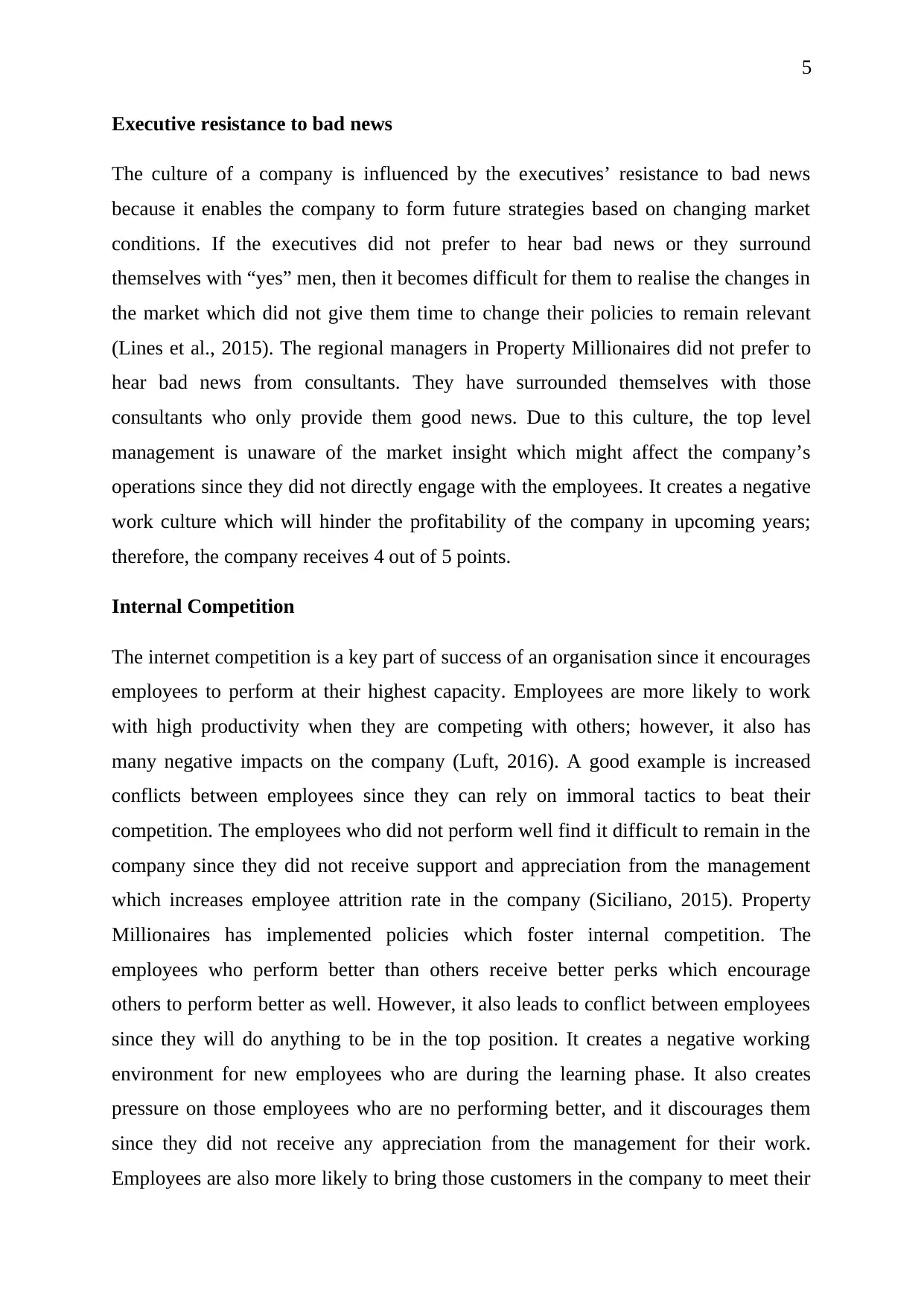
5
Executive resistance to bad news
The culture of a company is influenced by the executives’ resistance to bad news
because it enables the company to form future strategies based on changing market
conditions. If the executives did not prefer to hear bad news or they surround
themselves with “yes” men, then it becomes difficult for them to realise the changes in
the market which did not give them time to change their policies to remain relevant
(Lines et al., 2015). The regional managers in Property Millionaires did not prefer to
hear bad news from consultants. They have surrounded themselves with those
consultants who only provide them good news. Due to this culture, the top level
management is unaware of the market insight which might affect the company’s
operations since they did not directly engage with the employees. It creates a negative
work culture which will hinder the profitability of the company in upcoming years;
therefore, the company receives 4 out of 5 points.
Internal Competition
The internet competition is a key part of success of an organisation since it encourages
employees to perform at their highest capacity. Employees are more likely to work
with high productivity when they are competing with others; however, it also has
many negative impacts on the company (Luft, 2016). A good example is increased
conflicts between employees since they can rely on immoral tactics to beat their
competition. The employees who did not perform well find it difficult to remain in the
company since they did not receive support and appreciation from the management
which increases employee attrition rate in the company (Siciliano, 2015). Property
Millionaires has implemented policies which foster internal competition. The
employees who perform better than others receive better perks which encourage
others to perform better as well. However, it also leads to conflict between employees
since they will do anything to be in the top position. It creates a negative working
environment for new employees who are during the learning phase. It also creates
pressure on those employees who are no performing better, and it discourages them
since they did not receive any appreciation from the management for their work.
Employees are also more likely to bring those customers in the company to meet their
Executive resistance to bad news
The culture of a company is influenced by the executives’ resistance to bad news
because it enables the company to form future strategies based on changing market
conditions. If the executives did not prefer to hear bad news or they surround
themselves with “yes” men, then it becomes difficult for them to realise the changes in
the market which did not give them time to change their policies to remain relevant
(Lines et al., 2015). The regional managers in Property Millionaires did not prefer to
hear bad news from consultants. They have surrounded themselves with those
consultants who only provide them good news. Due to this culture, the top level
management is unaware of the market insight which might affect the company’s
operations since they did not directly engage with the employees. It creates a negative
work culture which will hinder the profitability of the company in upcoming years;
therefore, the company receives 4 out of 5 points.
Internal Competition
The internet competition is a key part of success of an organisation since it encourages
employees to perform at their highest capacity. Employees are more likely to work
with high productivity when they are competing with others; however, it also has
many negative impacts on the company (Luft, 2016). A good example is increased
conflicts between employees since they can rely on immoral tactics to beat their
competition. The employees who did not perform well find it difficult to remain in the
company since they did not receive support and appreciation from the management
which increases employee attrition rate in the company (Siciliano, 2015). Property
Millionaires has implemented policies which foster internal competition. The
employees who perform better than others receive better perks which encourage
others to perform better as well. However, it also leads to conflict between employees
since they will do anything to be in the top position. It creates a negative working
environment for new employees who are during the learning phase. It also creates
pressure on those employees who are no performing better, and it discourages them
since they did not receive any appreciation from the management for their work.
Employees are also more likely to bring those customers in the company to meet their
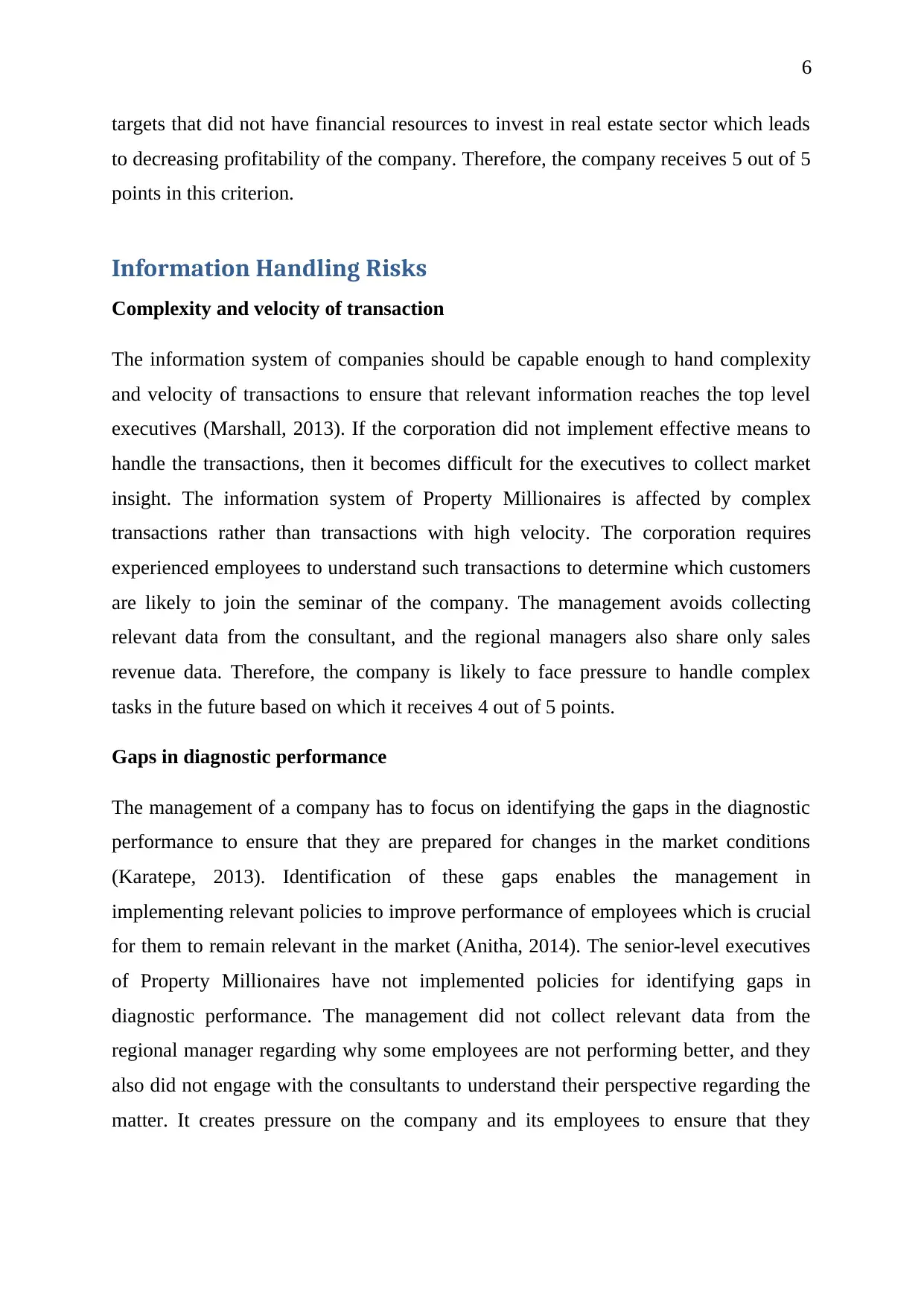
6
targets that did not have financial resources to invest in real estate sector which leads
to decreasing profitability of the company. Therefore, the company receives 5 out of 5
points in this criterion.
Information Handling Risks
Complexity and velocity of transaction
The information system of companies should be capable enough to hand complexity
and velocity of transactions to ensure that relevant information reaches the top level
executives (Marshall, 2013). If the corporation did not implement effective means to
handle the transactions, then it becomes difficult for the executives to collect market
insight. The information system of Property Millionaires is affected by complex
transactions rather than transactions with high velocity. The corporation requires
experienced employees to understand such transactions to determine which customers
are likely to join the seminar of the company. The management avoids collecting
relevant data from the consultant, and the regional managers also share only sales
revenue data. Therefore, the company is likely to face pressure to handle complex
tasks in the future based on which it receives 4 out of 5 points.
Gaps in diagnostic performance
The management of a company has to focus on identifying the gaps in the diagnostic
performance to ensure that they are prepared for changes in the market conditions
(Karatepe, 2013). Identification of these gaps enables the management in
implementing relevant policies to improve performance of employees which is crucial
for them to remain relevant in the market (Anitha, 2014). The senior-level executives
of Property Millionaires have not implemented policies for identifying gaps in
diagnostic performance. The management did not collect relevant data from the
regional manager regarding why some employees are not performing better, and they
also did not engage with the consultants to understand their perspective regarding the
matter. It creates pressure on the company and its employees to ensure that they
targets that did not have financial resources to invest in real estate sector which leads
to decreasing profitability of the company. Therefore, the company receives 5 out of 5
points in this criterion.
Information Handling Risks
Complexity and velocity of transaction
The information system of companies should be capable enough to hand complexity
and velocity of transactions to ensure that relevant information reaches the top level
executives (Marshall, 2013). If the corporation did not implement effective means to
handle the transactions, then it becomes difficult for the executives to collect market
insight. The information system of Property Millionaires is affected by complex
transactions rather than transactions with high velocity. The corporation requires
experienced employees to understand such transactions to determine which customers
are likely to join the seminar of the company. The management avoids collecting
relevant data from the consultant, and the regional managers also share only sales
revenue data. Therefore, the company is likely to face pressure to handle complex
tasks in the future based on which it receives 4 out of 5 points.
Gaps in diagnostic performance
The management of a company has to focus on identifying the gaps in the diagnostic
performance to ensure that they are prepared for changes in the market conditions
(Karatepe, 2013). Identification of these gaps enables the management in
implementing relevant policies to improve performance of employees which is crucial
for them to remain relevant in the market (Anitha, 2014). The senior-level executives
of Property Millionaires have not implemented policies for identifying gaps in
diagnostic performance. The management did not collect relevant data from the
regional manager regarding why some employees are not performing better, and they
also did not engage with the consultants to understand their perspective regarding the
matter. It creates pressure on the company and its employees to ensure that they
Paraphrase This Document
Need a fresh take? Get an instant paraphrase of this document with our AI Paraphraser
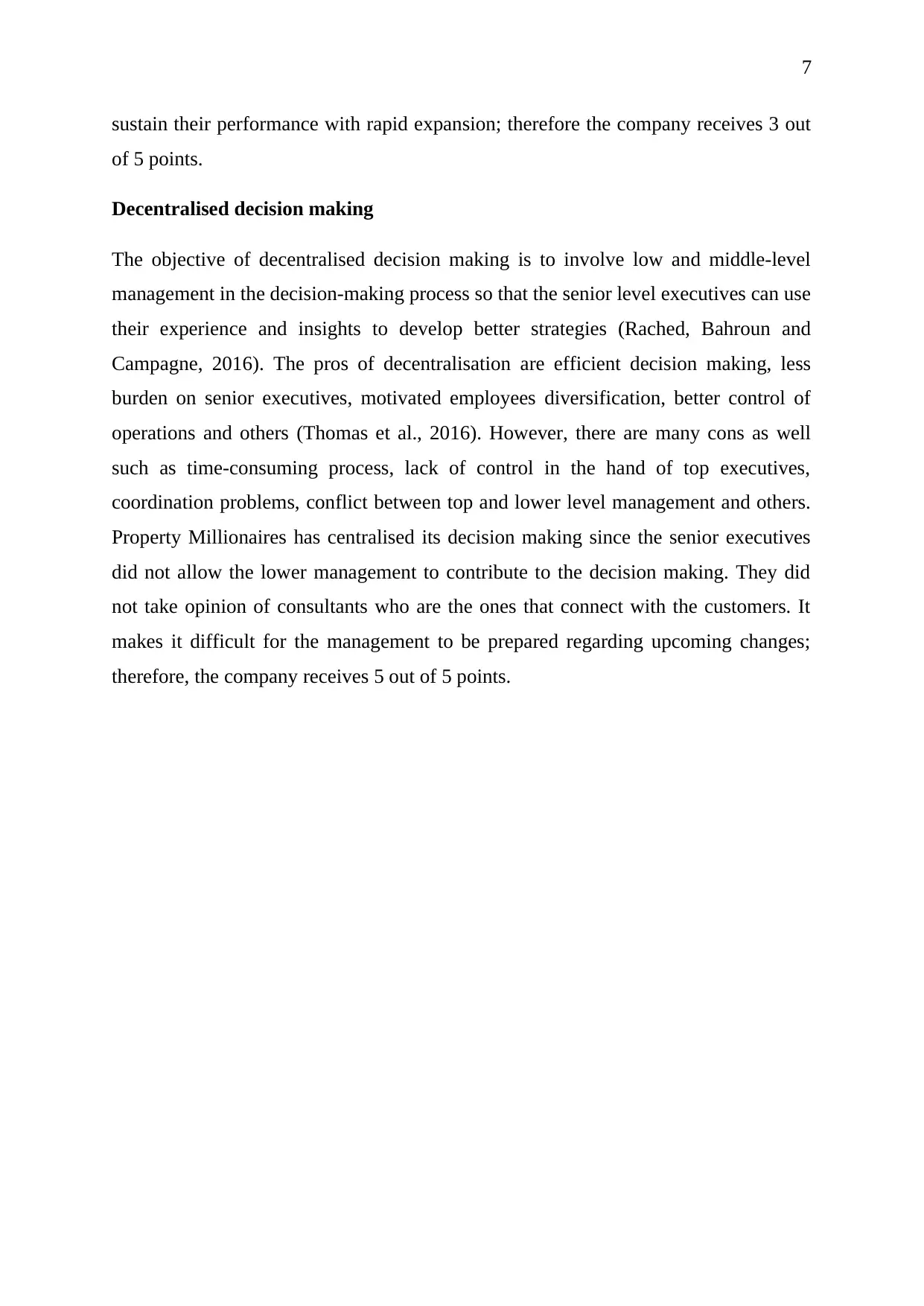
7
sustain their performance with rapid expansion; therefore the company receives 3 out
of 5 points.
Decentralised decision making
The objective of decentralised decision making is to involve low and middle-level
management in the decision-making process so that the senior level executives can use
their experience and insights to develop better strategies (Rached, Bahroun and
Campagne, 2016). The pros of decentralisation are efficient decision making, less
burden on senior executives, motivated employees diversification, better control of
operations and others (Thomas et al., 2016). However, there are many cons as well
such as time-consuming process, lack of control in the hand of top executives,
coordination problems, conflict between top and lower level management and others.
Property Millionaires has centralised its decision making since the senior executives
did not allow the lower management to contribute to the decision making. They did
not take opinion of consultants who are the ones that connect with the customers. It
makes it difficult for the management to be prepared regarding upcoming changes;
therefore, the company receives 5 out of 5 points.
sustain their performance with rapid expansion; therefore the company receives 3 out
of 5 points.
Decentralised decision making
The objective of decentralised decision making is to involve low and middle-level
management in the decision-making process so that the senior level executives can use
their experience and insights to develop better strategies (Rached, Bahroun and
Campagne, 2016). The pros of decentralisation are efficient decision making, less
burden on senior executives, motivated employees diversification, better control of
operations and others (Thomas et al., 2016). However, there are many cons as well
such as time-consuming process, lack of control in the hand of top executives,
coordination problems, conflict between top and lower level management and others.
Property Millionaires has centralised its decision making since the senior executives
did not allow the lower management to contribute to the decision making. They did
not take opinion of consultants who are the ones that connect with the customers. It
makes it difficult for the management to be prepared regarding upcoming changes;
therefore, the company receives 5 out of 5 points.
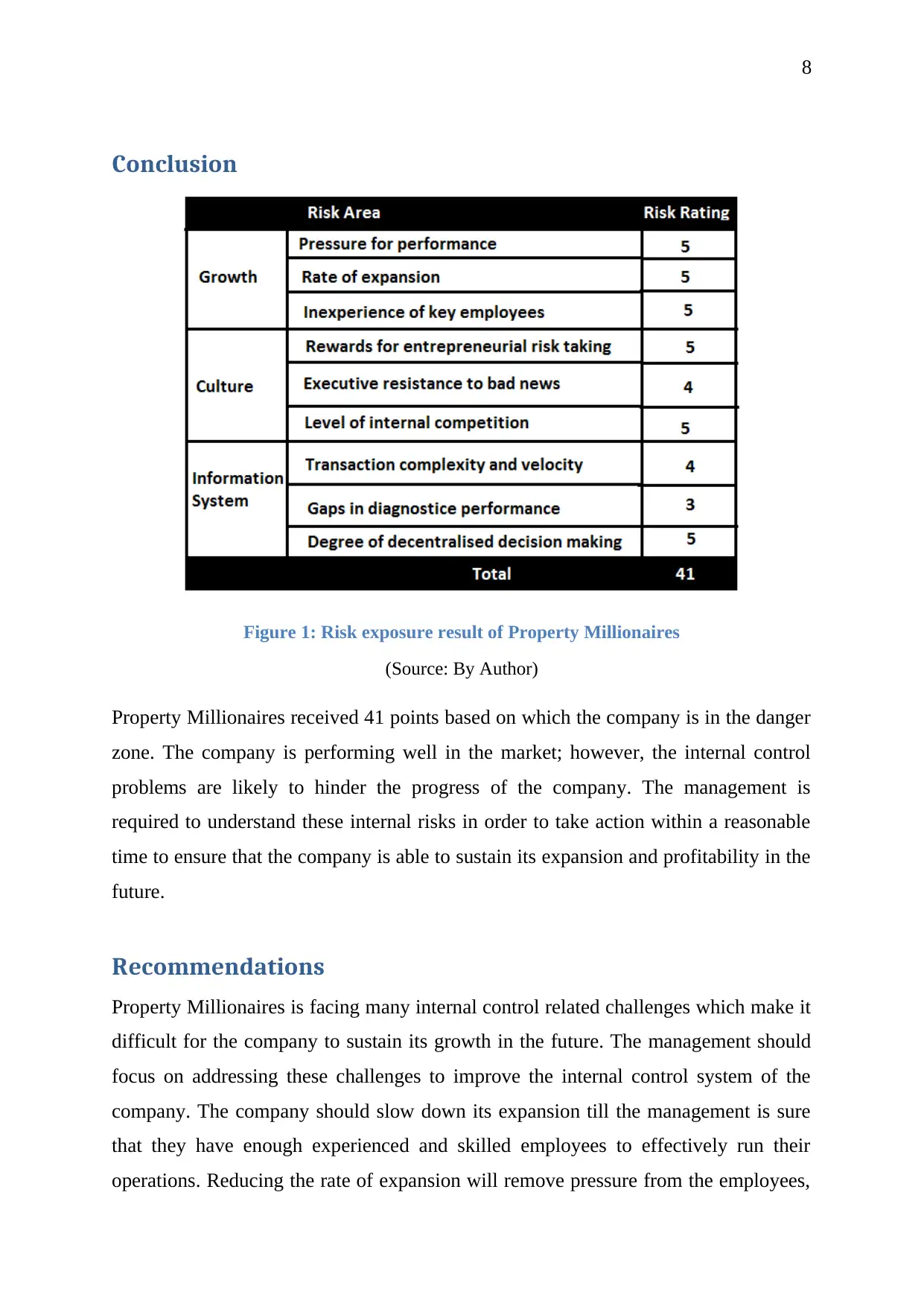
8
Conclusion
Figure 1: Risk exposure result of Property Millionaires
(Source: By Author)
Property Millionaires received 41 points based on which the company is in the danger
zone. The company is performing well in the market; however, the internal control
problems are likely to hinder the progress of the company. The management is
required to understand these internal risks in order to take action within a reasonable
time to ensure that the company is able to sustain its expansion and profitability in the
future.
Recommendations
Property Millionaires is facing many internal control related challenges which make it
difficult for the company to sustain its growth in the future. The management should
focus on addressing these challenges to improve the internal control system of the
company. The company should slow down its expansion till the management is sure
that they have enough experienced and skilled employees to effectively run their
operations. Reducing the rate of expansion will remove pressure from the employees,
Conclusion
Figure 1: Risk exposure result of Property Millionaires
(Source: By Author)
Property Millionaires received 41 points based on which the company is in the danger
zone. The company is performing well in the market; however, the internal control
problems are likely to hinder the progress of the company. The management is
required to understand these internal risks in order to take action within a reasonable
time to ensure that the company is able to sustain its expansion and profitability in the
future.
Recommendations
Property Millionaires is facing many internal control related challenges which make it
difficult for the company to sustain its growth in the future. The management should
focus on addressing these challenges to improve the internal control system of the
company. The company should slow down its expansion till the management is sure
that they have enough experienced and skilled employees to effectively run their
operations. Reducing the rate of expansion will remove pressure from the employees,
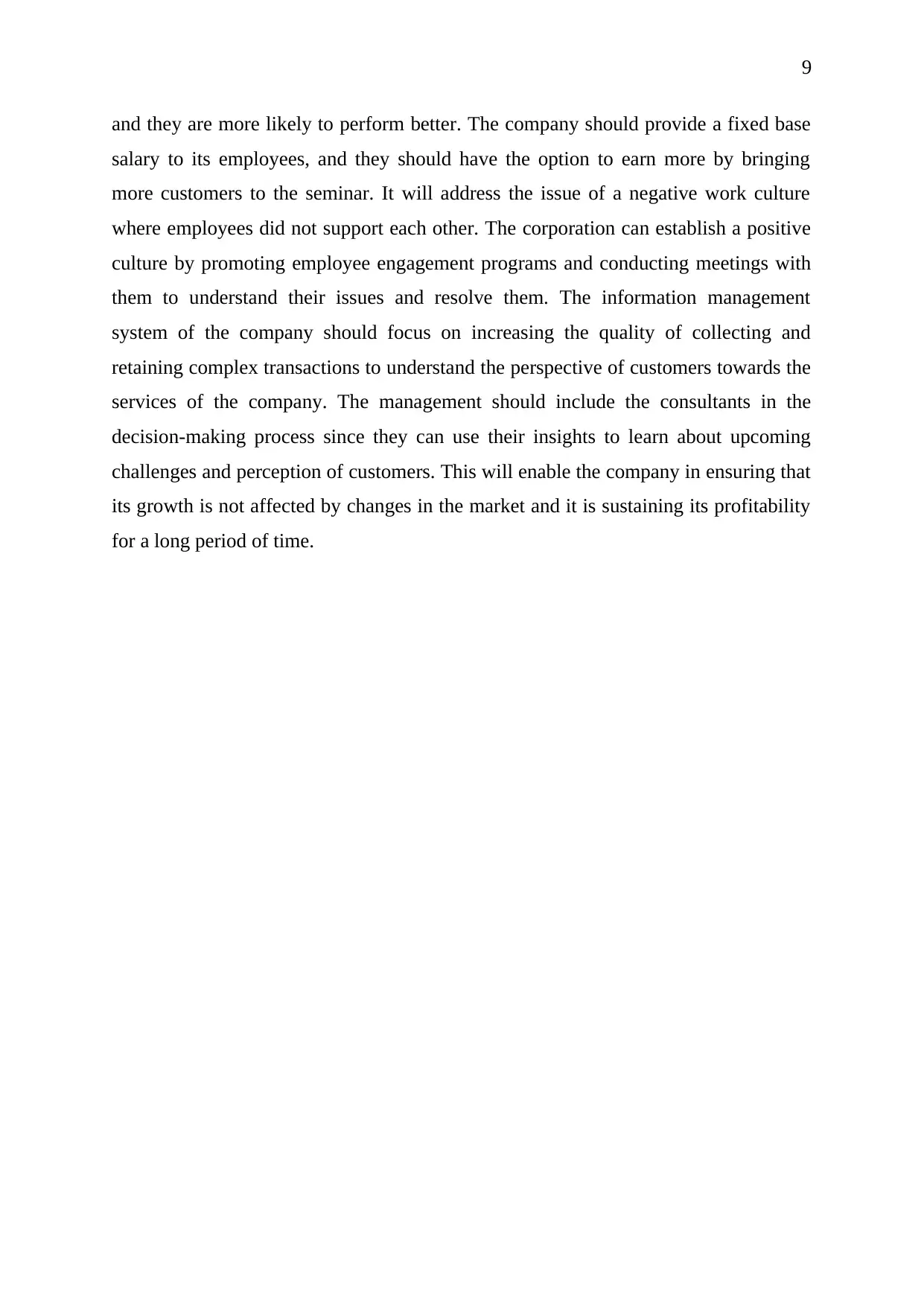
9
and they are more likely to perform better. The company should provide a fixed base
salary to its employees, and they should have the option to earn more by bringing
more customers to the seminar. It will address the issue of a negative work culture
where employees did not support each other. The corporation can establish a positive
culture by promoting employee engagement programs and conducting meetings with
them to understand their issues and resolve them. The information management
system of the company should focus on increasing the quality of collecting and
retaining complex transactions to understand the perspective of customers towards the
services of the company. The management should include the consultants in the
decision-making process since they can use their insights to learn about upcoming
challenges and perception of customers. This will enable the company in ensuring that
its growth is not affected by changes in the market and it is sustaining its profitability
for a long period of time.
and they are more likely to perform better. The company should provide a fixed base
salary to its employees, and they should have the option to earn more by bringing
more customers to the seminar. It will address the issue of a negative work culture
where employees did not support each other. The corporation can establish a positive
culture by promoting employee engagement programs and conducting meetings with
them to understand their issues and resolve them. The information management
system of the company should focus on increasing the quality of collecting and
retaining complex transactions to understand the perspective of customers towards the
services of the company. The management should include the consultants in the
decision-making process since they can use their insights to learn about upcoming
challenges and perception of customers. This will enable the company in ensuring that
its growth is not affected by changes in the market and it is sustaining its profitability
for a long period of time.
Secure Best Marks with AI Grader
Need help grading? Try our AI Grader for instant feedback on your assignments.
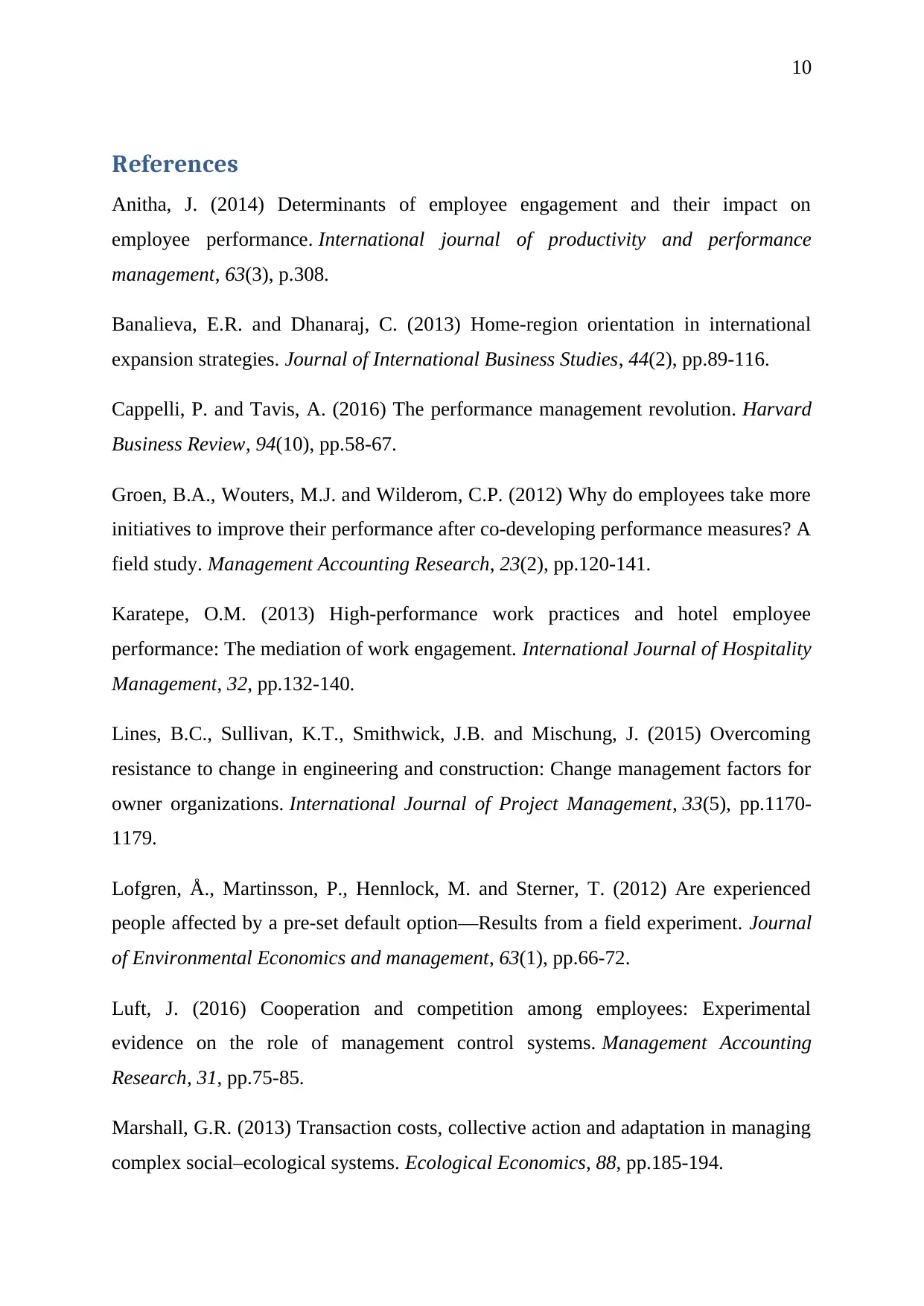
10
References
Anitha, J. (2014) Determinants of employee engagement and their impact on
employee performance. International journal of productivity and performance
management, 63(3), p.308.
Banalieva, E.R. and Dhanaraj, C. (2013) Home-region orientation in international
expansion strategies. Journal of International Business Studies, 44(2), pp.89-116.
Cappelli, P. and Tavis, A. (2016) The performance management revolution. Harvard
Business Review, 94(10), pp.58-67.
Groen, B.A., Wouters, M.J. and Wilderom, C.P. (2012) Why do employees take more
initiatives to improve their performance after co-developing performance measures? A
field study. Management Accounting Research, 23(2), pp.120-141.
Karatepe, O.M. (2013) High-performance work practices and hotel employee
performance: The mediation of work engagement. International Journal of Hospitality
Management, 32, pp.132-140.
Lines, B.C., Sullivan, K.T., Smithwick, J.B. and Mischung, J. (2015) Overcoming
resistance to change in engineering and construction: Change management factors for
owner organizations. International Journal of Project Management, 33(5), pp.1170-
1179.
Lofgren, Å., Martinsson, P., Hennlock, M. and Sterner, T. (2012) Are experienced
people affected by a pre-set default option—Results from a field experiment. Journal
of Environmental Economics and management, 63(1), pp.66-72.
Luft, J. (2016) Cooperation and competition among employees: Experimental
evidence on the role of management control systems. Management Accounting
Research, 31, pp.75-85.
Marshall, G.R. (2013) Transaction costs, collective action and adaptation in managing
complex social–ecological systems. Ecological Economics, 88, pp.185-194.
References
Anitha, J. (2014) Determinants of employee engagement and their impact on
employee performance. International journal of productivity and performance
management, 63(3), p.308.
Banalieva, E.R. and Dhanaraj, C. (2013) Home-region orientation in international
expansion strategies. Journal of International Business Studies, 44(2), pp.89-116.
Cappelli, P. and Tavis, A. (2016) The performance management revolution. Harvard
Business Review, 94(10), pp.58-67.
Groen, B.A., Wouters, M.J. and Wilderom, C.P. (2012) Why do employees take more
initiatives to improve their performance after co-developing performance measures? A
field study. Management Accounting Research, 23(2), pp.120-141.
Karatepe, O.M. (2013) High-performance work practices and hotel employee
performance: The mediation of work engagement. International Journal of Hospitality
Management, 32, pp.132-140.
Lines, B.C., Sullivan, K.T., Smithwick, J.B. and Mischung, J. (2015) Overcoming
resistance to change in engineering and construction: Change management factors for
owner organizations. International Journal of Project Management, 33(5), pp.1170-
1179.
Lofgren, Å., Martinsson, P., Hennlock, M. and Sterner, T. (2012) Are experienced
people affected by a pre-set default option—Results from a field experiment. Journal
of Environmental Economics and management, 63(1), pp.66-72.
Luft, J. (2016) Cooperation and competition among employees: Experimental
evidence on the role of management control systems. Management Accounting
Research, 31, pp.75-85.
Marshall, G.R. (2013) Transaction costs, collective action and adaptation in managing
complex social–ecological systems. Ecological Economics, 88, pp.185-194.
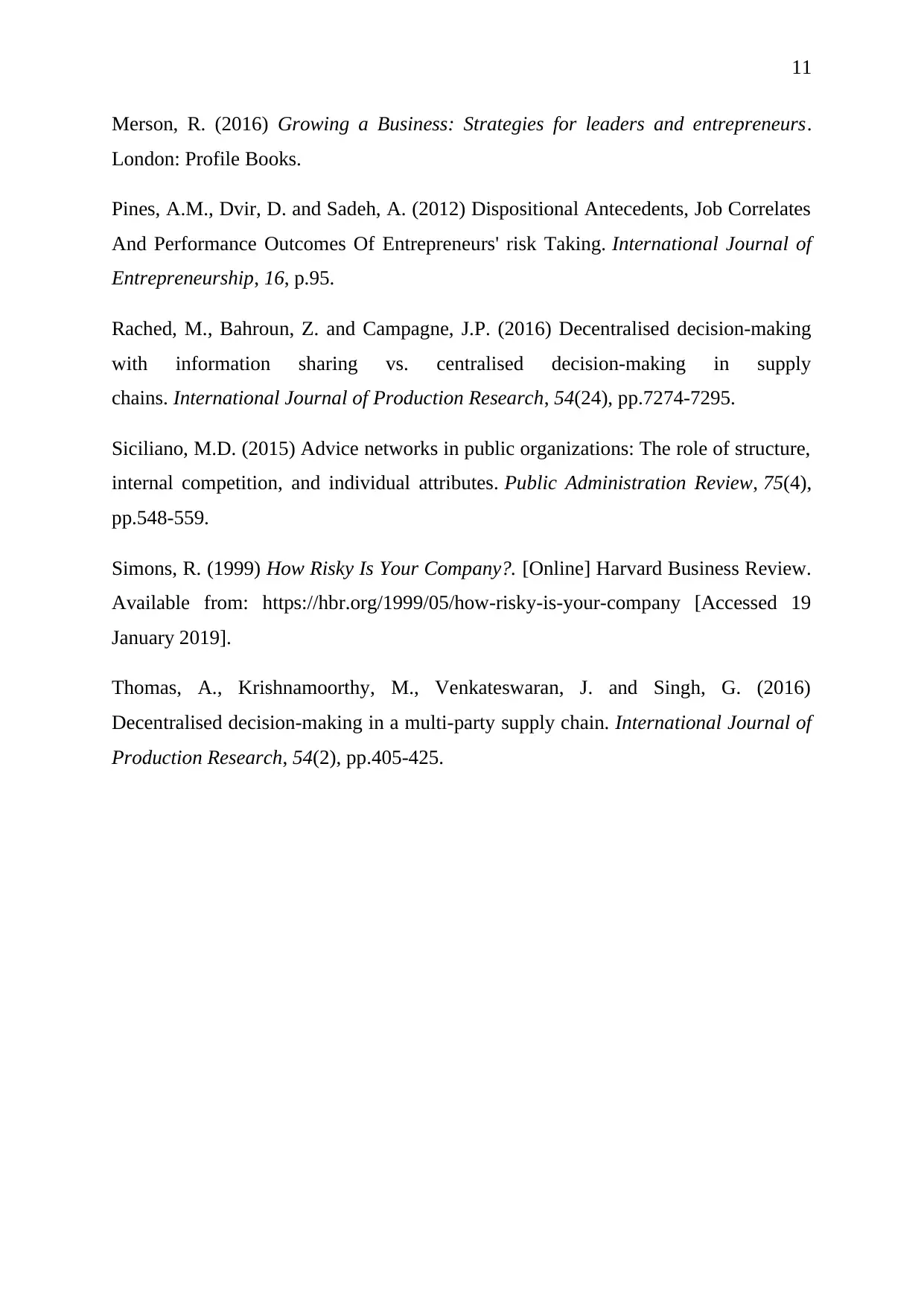
11
Merson, R. (2016) Growing a Business: Strategies for leaders and entrepreneurs.
London: Profile Books.
Pines, A.M., Dvir, D. and Sadeh, A. (2012) Dispositional Antecedents, Job Correlates
And Performance Outcomes Of Entrepreneurs' risk Taking. International Journal of
Entrepreneurship, 16, p.95.
Rached, M., Bahroun, Z. and Campagne, J.P. (2016) Decentralised decision-making
with information sharing vs. centralised decision-making in supply
chains. International Journal of Production Research, 54(24), pp.7274-7295.
Siciliano, M.D. (2015) Advice networks in public organizations: The role of structure,
internal competition, and individual attributes. Public Administration Review, 75(4),
pp.548-559.
Simons, R. (1999) How Risky Is Your Company?. [Online] Harvard Business Review.
Available from: https://hbr.org/1999/05/how-risky-is-your-company [Accessed 19
January 2019].
Thomas, A., Krishnamoorthy, M., Venkateswaran, J. and Singh, G. (2016)
Decentralised decision-making in a multi-party supply chain. International Journal of
Production Research, 54(2), pp.405-425.
Merson, R. (2016) Growing a Business: Strategies for leaders and entrepreneurs.
London: Profile Books.
Pines, A.M., Dvir, D. and Sadeh, A. (2012) Dispositional Antecedents, Job Correlates
And Performance Outcomes Of Entrepreneurs' risk Taking. International Journal of
Entrepreneurship, 16, p.95.
Rached, M., Bahroun, Z. and Campagne, J.P. (2016) Decentralised decision-making
with information sharing vs. centralised decision-making in supply
chains. International Journal of Production Research, 54(24), pp.7274-7295.
Siciliano, M.D. (2015) Advice networks in public organizations: The role of structure,
internal competition, and individual attributes. Public Administration Review, 75(4),
pp.548-559.
Simons, R. (1999) How Risky Is Your Company?. [Online] Harvard Business Review.
Available from: https://hbr.org/1999/05/how-risky-is-your-company [Accessed 19
January 2019].
Thomas, A., Krishnamoorthy, M., Venkateswaran, J. and Singh, G. (2016)
Decentralised decision-making in a multi-party supply chain. International Journal of
Production Research, 54(2), pp.405-425.
1 out of 12
Related Documents
Your All-in-One AI-Powered Toolkit for Academic Success.
+13062052269
info@desklib.com
Available 24*7 on WhatsApp / Email
![[object Object]](/_next/static/media/star-bottom.7253800d.svg)
Unlock your academic potential
© 2024 | Zucol Services PVT LTD | All rights reserved.





